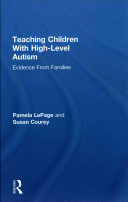Teaching Children with High level Autism Evidence from Families 1st Edition by Pamela LePage, Susan Courey 0415630827 978-0415630825
$50.00 Original price was: $50.00.$35.00Current price is: $35.00.
Teaching Children with High level Autism Evidence from Families 1st Edition by Pamela LePage, Susan Courey – Ebook PDF Instant Download/Delivery: 0415630827, 978-0415630825
Full download Teaching Children with High level Autism Evidence from Families 1st Edition after payment

Product details:
ISBN 10: 0415630827
ISBN 13: 978-0415630825
Author: Pamela LePage, Susan Courey
Teaching Children with High-Level Autism combines the perspectives of families and children with disabilities and frames these personal experiences in the context of evidence-based practice, providing pre- and in-service teachers and professionals with vital information on how they can help children with high-level autism reach their full potential. Many children with high-level autism are capable of regulating their behaviors given the right interventions, and this cutting edge text explores multiple methods for helping such children succeed academically, socially, and behaviorally. The book:
• draws from interviews with twenty families who have middle- and high-school-aged children
with high functioning autism or Aspergers syndrome;
• presents a synthesis of the most cutting-edge research in the field;
• provides practical advice for educating children with high-level autism;
• is authored by two special education professors who are also both the parents of children with
disabilities.
Teaching Children with High-Level Autism is essential reading for anyone who works or plans to work with children on the upper range of the autism spectrum.
Teaching Children with High level Autism Evidence from Families 1st Table of contents:
Chapter 1 Introduction
What Is This Book About?
Teaching Children With High-Level Autism: A New Population
The Change in Diagnostic Criteria
Interviewing Families
Conclusion
Chapter 2 Autism Basics, Prevalence and Causes
What Is Autism?
Classic Autism
Asperger’s Disorder or Syndrome
Childhood Disintegrative Disorder
Rett’s Disorder or Syndrome
Pervasive Developmental Disorder Not Otherwise Specified (PDD-NOS)
Autism and Demographic Information in the United States
What Causes Autism?
Intellectual Disabilities
Does Autism Go Away?
Chapter 3 Characteristics of Children With Autism
Four Types of Social Interactions of Children with ASD
Characteristics of Children With High-Level Autism
Movements: Stimming
Sensory Issues: Too Bright, Too Loud, Too Crunchy
Obsessions and Fascinations: Should We Support a One-Track Mind?
Motor Skills
Comorbid Disorders
Developmental Stages for Children With Autism
Conclusion
Chapter 4 Profiles of Families
Methods
Research Participants
Interviews
Context of the Area
Introducing Families
Results
Parent Interviews
Early Intervention
Emotional Issues for Children
Instructional Issues
Emotional Issues for Parents
Children
Teachers and Bullying
Friends
Conclusion
Chapter 5 Cognition and Information Processing
Exploring the Myths
Children With Autism and Technology
Technology Geeks?
Parents as Engineers
Do Children With Autism Have Savant Characteristics?
Weak Central Coherence
Memory
Interval Timing: What Is It, and Why Do We Care?
Cognition Style Meant to Explore and Discover?
Brain Imaging
Comparing Boys and Girls
Intelligence Testing
Wisc-III
Stanford-Binet
Raven’s Progressive Matrices
How Can Teachers Use This Unique Cognitive Profile to Improve Instruction?
Conclusion
Chapter 6 Socialization
Social Development
Mind-Blindness and Theory of Mind
Mind-Blindness
Theory of Mind
Social Skills Development
Cognitive Social Interventions: Social Thinking
Play-Based Socialization in Naturalistic Settings
Socialization Groups
Identity Awareness
Autism Awareness
Levels of Participation in Activities
Research on Social Interactions at School
Helping Children Make Friends
Bullying
Building a Community of Parents
Conclusion
Chapter 7 Evidence-Based Practices: Looking at Research Critically
The National Autism Center
Best Practices
Emerging, Unestablished, or Harmful Research
The National Professional Development Center
Interagency Autism Coordinating Committee
Meta-Analysis
Limitations
Problems With Language in Research Literature
Conclusion
Chapter 8 Teaching Methods From Autism’s Past
Applied Behavior Analysis (ABA)
What Is Behaviorism?
Criticisms of Behaviorism
ABA and the Autism Treatment Debate: It’s About the Money
Looking at Five ABA Methods
Lovaas
Discrete Trial Training
Pivotal Response Training (PRT)
Incidental Teaching
The Developmental, Individual Differences, Relationship-Based (DIR) Model/Floortime
Teacch
The Ziggurat Model
Scerts
Conclusion
Chapter 9 Diagnoses, Early Intervention, and Preschool
Diagnostic Overview: Autism, High-Functioning Autism, and Asperger’s Syndrome
Diagnostic Assessments
Red Flags for Autism
Joint Attention, Play, and Therapy
Play Interventions
Therapy for Young Children
Support for Parents After Diagnosis
Later Diagnosis
Helping Parents Be Social
Chapter 10 Elementary School
Development in the Elementary Years
Relationships With Adults
Strengths
Academic Supports
Group Work and Peer Teaching
Visual Supports and Social Stories
Literacy
Anaphoric Expressions
Learning to Use the Computer
Reciprocal Teaching
Recess
Chapter 11 Middle School
Academic Supports
Tools for Organization
Arts-Based Teaching
Physical Education
How Social Knowledge is Tied to Academics
Socializing in Middle School
Resisting the Changes
Unstructured Time
Chapter 12 High School
Differences Between Girls and Boys
Thoughts on Behavior
Helping Teenagers Become Self-Advocates
Finding a Niche
Executive Functioning With Teenagers
Transition Planning
Life as an Adult
Parent
Chapter 13 Teaching Strategies—NOS (Not Otherwise Specified)
Growth Mindset
Advice From Parents
Characteristics of Good Teachers
Teachers Get to Know Them, Accommodate for Them, and Make Learning Fun
Teachers Who Helped Them With Schoolwork
Teachers (and Other Staff) Who Spent the Time Talking and Listening to Them
Teachers Who Were Fair
What Problems Did Parents Have With Teachers and Schools?
Not Good With Children
Inflexible/Not Respectful of Parents
Not Accepting of Differences
Conclusion
Chapter 14 Behavior and Classroom Management
Developing a Strong Foundation for Classroom Management
Providing Quality Instruction
Investing Time at the Beginning of the Year
Developing a Welcoming and Functional Physical Environment
Sensory Issues for Children With Autism
Establishing a Good Communication System
Comment from a Parent
Comments from Teenagers
A Data-Driven Behavior Management Plan
Behavioral Foundations of Classroom Management
Measuring Goals and Objectives
Collecting Behavioral Data
Self-Management and Choice
Developing Community
From Rules to Citizenship
Developing Friends and Interacting With Peers
Communicating With Parents
Chapter 15 Working With Parents
Do Parents of Children With Autism Feel Supported?
Differences Between Mothers and Fathers
Parents’ Experiences Seeking Interventions
Parents’ Depression
Issues of Marriage
Reactions to Children’s Diagnoses
The Problem With Blame
Parents’ Choices
Disclosing Information About Autism
Should Kids With Autism Be Together as Friends?
Teachers’ and Parents’ Assessment of Abilities
Homework Hell
Placing Children
Providing Support
Coping Strategies
Chapter 16 Conclusion
Supports Children With High-Level Autism Need to Succeed
A Four-Pronged Approach
Social Supports Organized Around a Developmental Process
Parents’ Pride in Their Children
Believing Their Child Will Succeed: Seeing No Limits
Ability to Talk About Feelings
Being a Good Citizen
Doing Well in Spite of Challenges
Being Competent and Impressive/Role Models
Index
People also search for Teaching Children with High level Autism Evidence from Families 1st :
teaching children with high level
teaching students with high incidence disabilities
teaching child development in high school
teaching high leverage practices
Tags:
Pamela LePage,Susan Courey,Teaching Children


